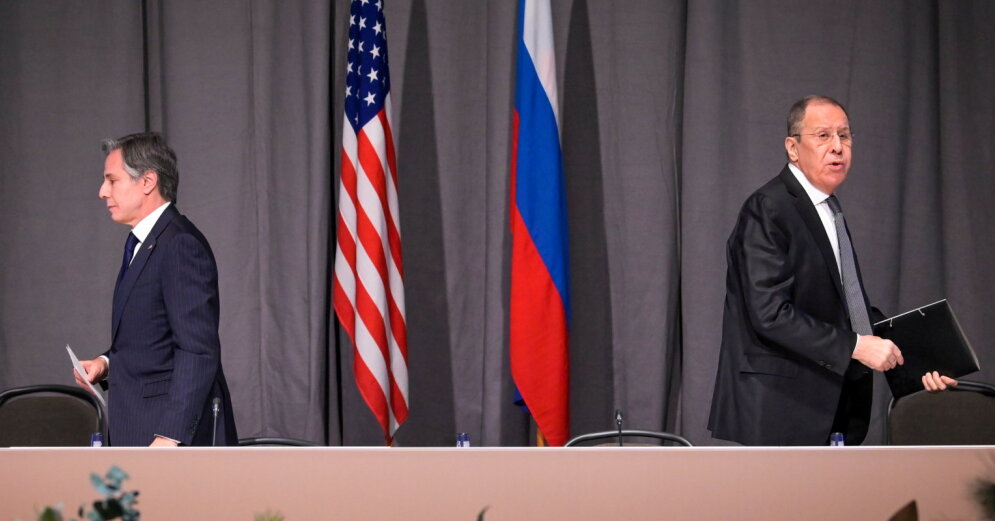Cuba stands apart from most other countries when it comes to vaccine coverage and pandemic outcomes.
Cuba has vaccinated children and adolescents from 2 years of age. Photo: Adalberto Roque / AFP
–
Cuba has been remarkable in many ways. The country produces its own vaccines and has one of the highest vaccination coverage rates in the world. When it comes to the results of the pandemic, this seems to be paying off.
The panorama of vaccines in Cuba
Cuba not only distinguishes itself from most countries by being a vaccine manufacturer, but the vaccines it produces are not the typical 2-dose regimen. The Cuban vaccination panorama consists of protocols of 1 and, mainly, of 3 doses. This is the exact opposite of the rest of the world, which disproportionately relies on 2-dose protocols.
Cuba currently manages Abdala, Soberana 2 and Soberana Plus. Abdala is a 3-dose protocol, Soberana 2 combined with Soberana Plus is a 3-dose protocol for children, and Soberana Plus is only a 1-dose protocol for those with a history of COVID.
This diversity of protocols matters a great deal as it greatly complicates Cuba’s comparison with the rest of the world. If we were to take the dose data at face value, it would be easy for Cuba to rank favorably as its people need to get more doses to be considered fully covered (i.e. 3 instead of the typical 2) . In contrast, other countries that rely more on 1-dose protocols would compare unfavorably.
To address this concern, we must do things differently. Here’s a new method to compare global vaccination progress and avoid apples-and-oranges comparisons: We convert all administered doses to double-dose equivalents and apply this transformation to every country in the world. In other words, we use the standard 2-dose protocol (which is the most common worldwide) as a benchmark.
In practical terms, we converted the doses from the 1- and 3-dose protocols to 2-dose equivalents by multiplying by 2 and 2/3, respectively, before adding and dividing by the total population. (For more details on the data for Cuba, see the note at the end of this post.)
It’s as simple as that.
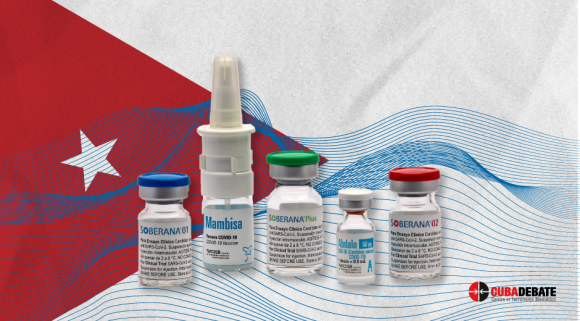
Comparison of advances in vaccination in Cuba
Using the above methodology, let us examine the evolution of Cuba’s vaccine coverage rate. Remember that this relationship measures the adjusted doses in relation to the total population and achieves, thanks to the adjustment, a maximum of 200 when the population is completely covered or completely vaccinated according to the vaccination protocols.
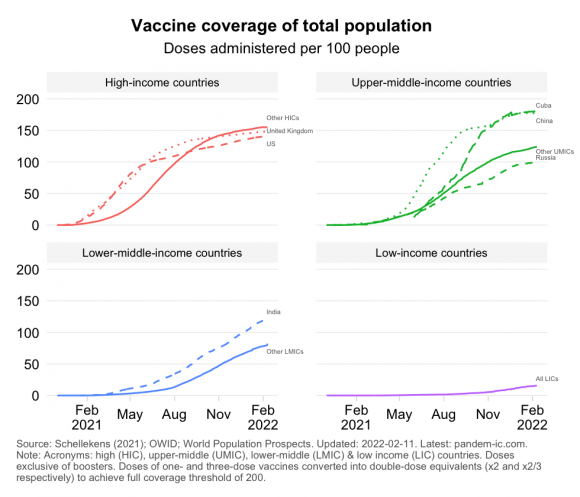
Vaccination coverage for the total population. Doses administered per 100 people
–
We can immediately see that Cuba has done a stellar job. For one thing, it has outperformed its peers in upper-middle-income countries. Initially, the vaccination effort got off to a slow start, although it was no different from any other country in the world. But in the early summer of 2021, Cuba accelerated its vaccination campaign and managed to increase coverage very quickly. As a result, it caught up with China, which is also a world leader. At this point, Cuba has almost completed the primary vaccination cycle and is far ahead of most other countries.
Let’s also bring the boosters into the picture. The chart below is a snapshot of global vaccination progress that breaks down total vaccination into primary and booster vaccination. It shows all the countries of the world (see the outer edge) and groups them according to the World Bank’s income classification into high income (HIC), upper middle income (UMIC), lower middle income (LMIC) and low income (LIC). ) countries.
The vertical axis on this graph with polar coordinates represents two variables on different scales. The first in dark blue is the primary vaccination coverage rate (as in the graph above), scaled from 0 to 200. The second in light blue is the booster coverage rate (unadjusted boosters per 100 people) on a scale of 0 to 200. 100 (100 for now, as most countries are still in their first booster cycle, while many have not yet started boosting). The 3-letter country codes in the outer circle are a bit small, which is why CUB is highlighted in red. Look for it in the lower right quadrant of the UMICs.
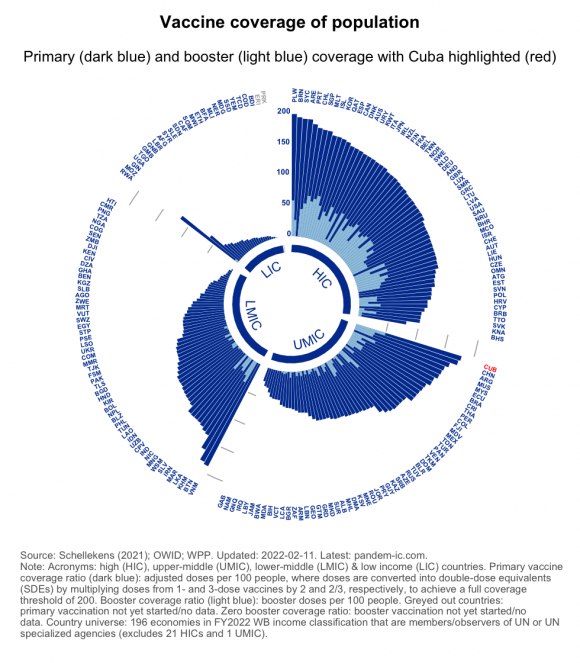
Initial (dark blue) and booster (light blue) vaccination coverage, with Cuba underlined in red
–
What would the international comparison look like if we were to consider “total vaccine coverage”? Total vaccine coverage takes into account primary and booster vaccine coverage simultaneously. That’s what the following image is about.
Using the same methodology, we group adjusted primary injections and booster injections into a composite indicator and express it relative to the total population. Let’s first look at the universe of developing countries and identify the top 20 countries among them in terms of total vaccine coverage.
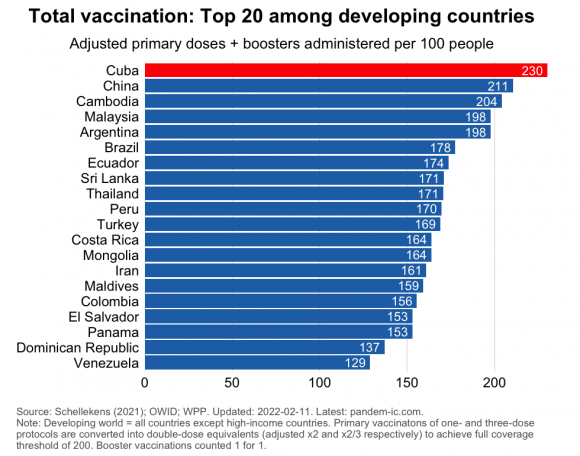
Top 20 developing countries in vaccination against COVID-19
–
Pandemic Results
Cuba’s high rate of vaccine coverage seems to be paying off when we look at the results of the pandemic in the country. Next, we will look at cases and deaths and make some international comparisons.
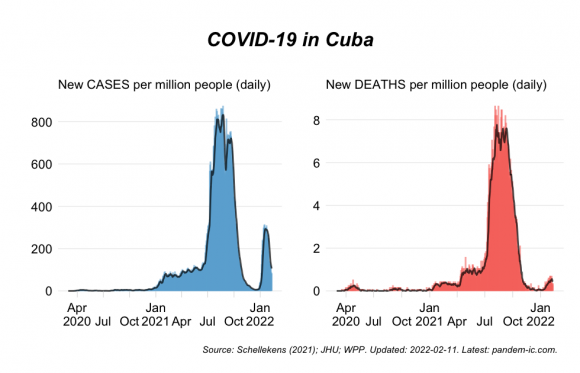
Covid-19 in Cuba
–
Let’s start with the home image first. The following graph shows the evolution of confirmed cases and deaths, both expressed per million people. These are daily numbers calculated as a final weekly average.
What is most striking about the chart above is the muted nature of Omicron/Delta’s recent rally. New cases in Cuba did not exceed, or even come close to, their previous peak, which contrasts sharply with most other countries in the world. Along the same lines, the impact on mortality has been small, which is a more common pattern internationally.
Let’s analyze this in more detail and compare the experience of Cuba with that of other countries, focusing first on the cases. The graphs below show the peak case rates before and after the Omicron/Delta surge, where the cutoff date is considered to be November 1, 2021. Therefore, for the peak case rate before this date, we calculate the maximum daily peak (again on a weekly basis). moving average basis for trading) observed throughout the pandemic period up to the cut-off date. For the period after November 1, we do the same thing and calculate the maximum value that will capture the most intense moment of the recent Omicron/Delta wave.
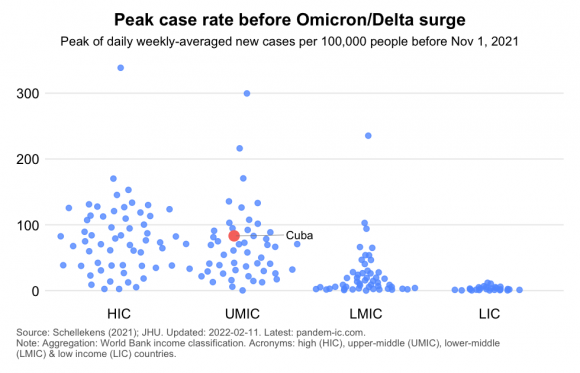
Peak of average cases before the impact of Omicron / Delta. November November 1, 2021
–
The graph tells us that Cuba’s peak number of cases before the recent Omicron/Delta wave was reached around August 2021. Vaccination at that time had only just begun to accelerate. Now let’s look at the case data after the deadline. You can see that during the most recent wave, the peak case rates in Cuba have been very low.
Vaccines are less effective in protecting against infection than in preventing serious morbidity or mortality outcomes. Let’s focus on the mortality results and place Cuba’s mortality spikes before and after November 1, 2021 in an international perspective. The chart below tells us that the peak mortality levels were on the low end before the cutoff date. Subsequently, death rates became extremely low both in absolute terms and relative to other upper-middle-income countries and indeed the rest of the world.

Mortality spike before Omicon/Delta (before November 1, 2021)
–

Mortality peak after November 1, 2021, Omicron / Delta peak
–
Cuba’s experience has been truly remarkable. The country stood out in terms of developing and producing its own vaccines. Thanks to that, it was able to increase vaccine coverage very quickly, a local advantage that other vaccine-making nations have taken advantage of. Success on the vaccination side appears to have resulted in very good pandemic outcomes, especially on the mortality side. Of course, there are other factors at play, but the results are impressive.
The history of Cuba is a history that we would like to see repeated in other parts of the world. It is critically important that vaccine production be less geographically concentrated and that manufacturing capabilities be more widely shared. Looking ahead, we don’t know what Mother Nature has in store for us. It is quite possible that another dangerous variant will emerge that will challenge existing immunities and vaccines. It is for this fundamental reason that the Cuban experience needs to be emulated.
Note on the Cuban vaccine panorama
Cuba stands out not only for its impressive vaccination record so far, but also for the fact that it has developed several vaccines of its own.. What also sets Cuba apart is that the vaccines it has developed are not the typical 2-dose regimen. Cuba currently administers three types of protocols: Abdala (3-dose vaccine), Soberana 2 combined with Soberana Plus (considered a 3-dose vaccine for children), and Soberana Plus alone (considered a 1-dose vaccine for those with a history of COVID). . Note that in the data published by Cuba, Soberana Plus when combined with Soberana 2 is treated as the third dose of a three-dose vaccination protocol and not as a booster.
How do we account for this diversity of vaccines in the adjusted vaccine coverage indicator where doses are converted to double dose equivalents? The logic is simple, but adjusting the numbers requires some permutations. We first need to scrape the data making sure to include in our variables the numbers of (1) total doses administered, (2) people vaccinated with three doses, and (3) people fully vaccinated (data not currently available in Our World in Data) . The total doses administered under the 1-dose protocol (Soberana Plus stand-alone) then equal (3) – (2), while the total doses under the 3-dose protocols (Abdala and the combination of Soberana 2 and Plus) are equal to (1) – ( 3) + (2) . The next step is to multiply the single dose protocol doses by 2 and the three dose protocol doses by 2/3. Add it all up and then we have our adjusted measure that is comparable across countries.
The Cuban case clearly illustrates the value of the indicator. Let’s pick an arbitrary date, October 29, 2021, and examine the numbers. If we were to use unadjusted per capita doses, Cuba’s vaccination coverage rate would be 225 doses per 100 people, the highest in the world among 196 countries. The adjusted coverage rate, on the other hand, would be 154 doses per 100 people. This is much lower than the unadjusted number because currently around 99% of Cuban vaccine doses administered require three injections.
(Taken from pandem-ic.com / Translation Cubadebate)
–


